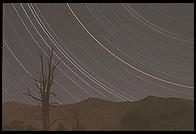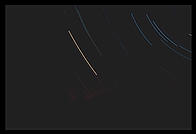
Star Streaks
a tutorial by Philip Greenspun; revised January 2008
Site Home : Photography : Star Streaks

a tutorial by Philip Greenspun; revised January 2008
Site Home : Photography : Star Streaks
The photo at left is from the Ancient Bristlecone Pine Forest, 10,500' above sea level in the White Mountains of California. The tree in the foreground is probably 3,000 years old. They grow slowly in the dry climate that results from being in the rain shadow of the Sierra Mountains across the Owens Valley to the east.
The photo was taken in 1992 with a then-fairly-new Nikon 6006 autofocus SLR. The camera sat on a tripod, facing east, with a 60/2.8 macro lens on the front. The aperture was f/4 for ISO 50 color negative film ("print film"). I opened the shutter with a cable release and screwed down the lock, then went to sleep for six hours. As the morning began to brighten, around 4:30, I unscrewed the cable release. No clunk. No motor drive whirr. It seemed that the lithium battery had died. I put a lens cap onto the front of the lens to block stray light and inserted a new battery. The shutter/mirror thunked closed and the camera wound up to the next frame. I then repeated this procedure with a Nikon 8008 on an adjacent tripod.

The Nikon 8008 had been loaded with a favorite landscape film, Fuji Velvia. Due to the higher contrast of slide film, though, the resulting image (at right) was much less interesting. Color negative film compresses the contrast in the original scene, so faint star trails were recorded right alongside the bright ones. Both the slide and negative films recorded brilliant colors where my eye could see none.
Some advice for star trail photography:
Insist on using film? Find an old manual camera, e.g., a Nikon FM or F3. Get a locking cable release ($5) to hold the shutter, set on B, open all night, unless the camera has a T setting. Use ISO 100 color negative film with an exposure of f/5.6 or f/8.
If you can't find a moon-free night, maybe try to get a good photo of the moon itself...
Start with a tripod and a 200mm or longer lens. Your exposure should be f/11 and a shutter speed of 1/ISO (e.g., f/11 and 1/100th of a second if the camera is set for ISO 100). The moon is illuminated by the full light of the sun, attenuated to some extent by our atmosphere. You could say the same about your friend's face on a sunny day, in which case you'd apply the "sunny 16 rule" and set f/16 and 1/ISO. Why the discrepancy? The moon is made of darkish gray rock. But we see it at night when are eyes are adjusted to the dark so it looks rather white. In order to have the moon appear white in the final image , you need to overexpose it by 1 f-stop, i.e., use f/11 instead of f/16.
Text and pictures copyright 1996-2008 Philip Greenspun.